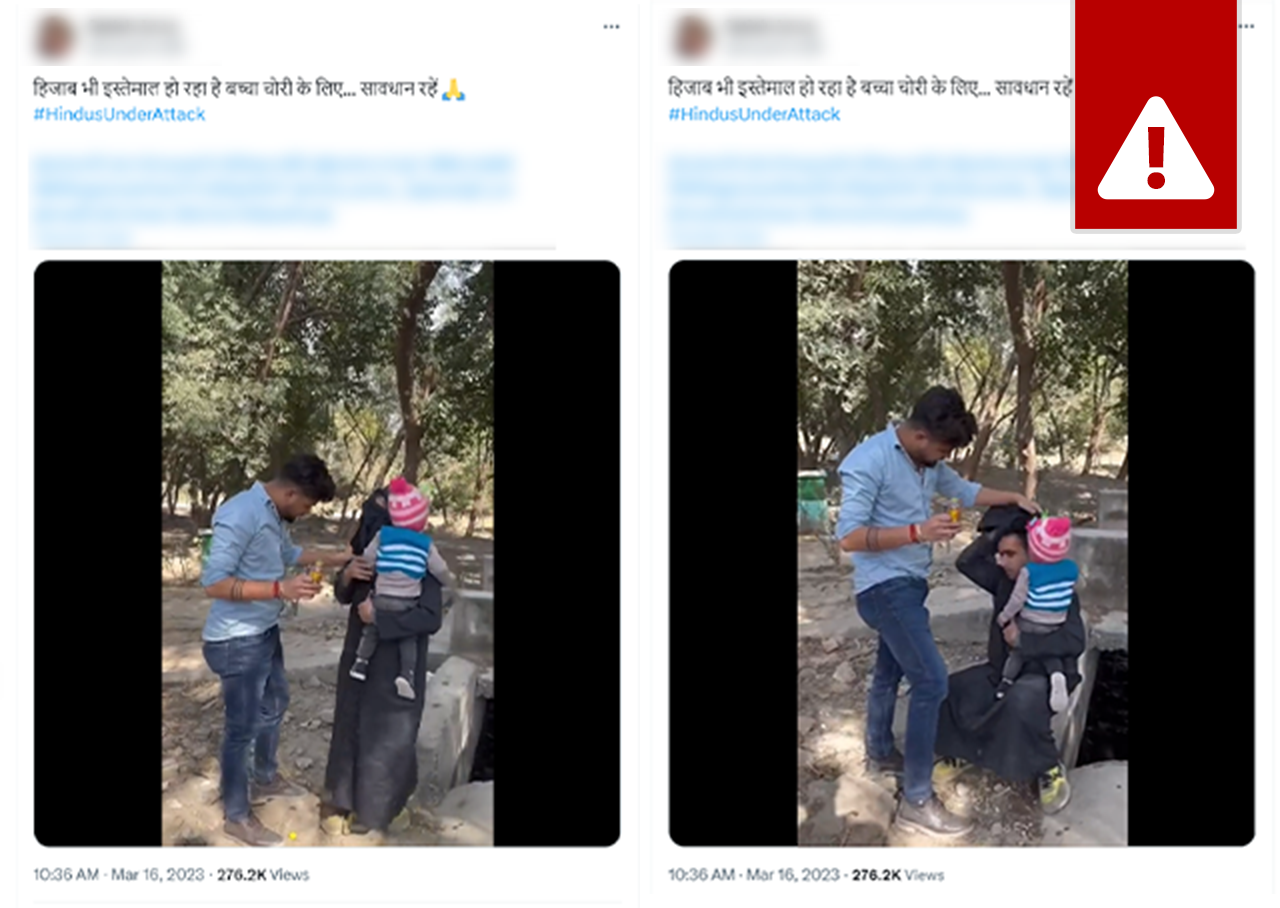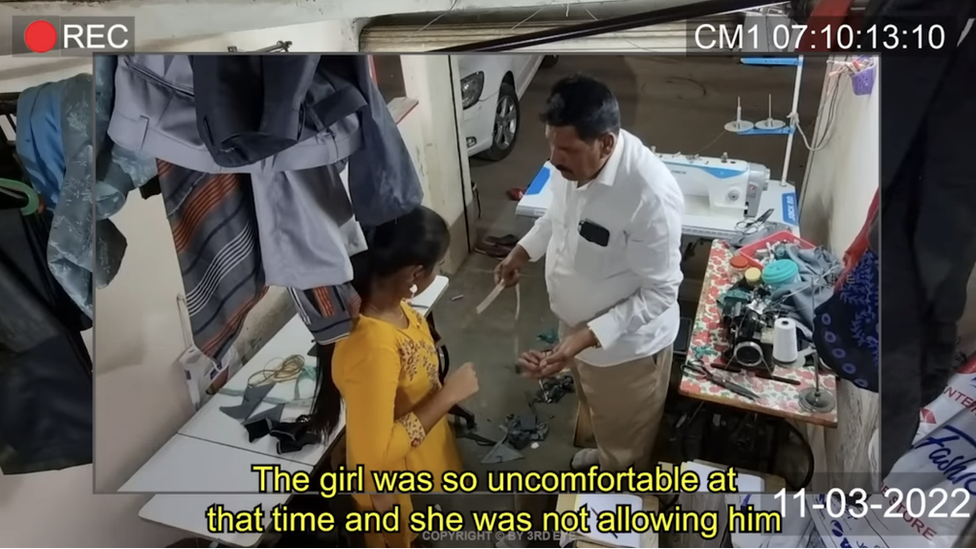Staged videos fuel religious hate and misogyny in India
- Published

A dramatised video shows a man dressed in a burka being caught while "kidnapping" a child
In a video shared and watched by millions of people in India, a man is seen attacking a person who is wearing a black burka and holding a child. He then forcibly removes the burka to reveal a man.
The message accompanying the clip warns in Hindi that people should "be aware" of criminals using the burka - a veil used by Muslim women around the world - to disguise themselves and "kidnap children".
The video, published on YouTube earlier this year, has been viewed more than 29 million times before it was deleted.
But it did not show real events. It was a dramatisation - a scripted performance with amateur actors.
Scripted videos, apparently created for entertainment, are increasingly being shared on social media as true events in India. Often accompanying the videos are false claims that stoke religious hatred and misogyny.
India has witnessed growing tension among religious communities, particularly between Hindus and Muslims, since Prime Minister Narendra Modi's Hindu-nationalist Bharatiya Janata Party (BJP) came to power in May 2014. Many of the false narratives that target these communities also encourage moral policing against women.
This trend of dramatised videos has reached multiple Indian languages, including Hindi, Tamil, Malayalam, Gujarati, Marathi and Telugu. Sometimes, local media outlets have also mistaken staged videos for news.
Many of the staged videos show people wearing burkas in order to kidnap children. This could have real-life consequences - over the past few years, authorities in many Indian states have had to issue warnings against fake news after several people were attacked by mobs believing them to be kidnappers.
Why are these videos dangerous?
These dramatised videos are accompanied by disinformation tactics which may confuse viewers on social media. Some have disclaimers but they may be hidden in the middle or the end of the videos.
Most times, the text is in English, which is not always understood by viewers.
According to a fact-check by Alt News, the original clip of the man wearing a burka - which was later deleted by its creator - actually had a disclaimer stating it was "a work of fiction". But it was visible only for a second.
Other creators add CCTV templates to make the videos seem more realistic.
One such video, which went viral in December 2021, was shared alongside claims without evidence in multiple languages that Muslim men were trying to intoxicate Hindu girls by spiking their food.
In the comment section below the video, many users appeared to believe it was true, making Islamophobic remarks. "Beware of love jihad," commented a user.
"Love jihad" refers to a conspiracy theory which claims that Muslim men are wooing Hindu women to convert them to Islam.
Most videos made by Hyderabad-based creator Venkat Seepana feature a recording sign and time-stamp like CCTV clips. His YouTube channel has over 1.2 million subscribers and more than 400 videos.
One clip depicted a tailor misbehaving with a woman. It was shared multiple times on Twitter and Facebook with claims that it showed a Muslim man mistreating a Hindu woman: "Hindu sisters and daughters are requested not to go to the shops of Muslims, they are people with a bad mentality."

One of Seepana's videos depicted a tailor misbehaving with a woman
Seepana told the BBC that he made these videos to "spread awareness and show real-life situations".
Alishan Jafri, a journalist and disinformation researcher, says that dramatisations that go viral may not lead to physical violence. But they deepen existing religious biases.
"These videos are adding fuel to the fire in the society that is already divided and polarised. Most of these videos are targeted against certain communities, particularly Muslims, and when they go viral, they contribute to structural violence against the minority community," he says.
Sometimes, these scripted videos - which spread confusion in the first place - are used to sow even more disinformation online.
Some of them portray illicit relationships between friends, family members and people with a huge age difference.
Two such staged videos were widely shared in May with false claims attacking the Hindu community.
The first one depicted a man dressed in saffron - a colour associated with Hinduism - who claims he is marrying his sister.
In the second video, the same woman is shown standing next to him in a burka and he says he is marrying her to convert her to Hinduism.
On Twitter the clips were used by some to claim that this was a Hindu man who was making his sister pretend to be a Muslim woman.
Both the man and woman seen in the two videos appear in several other videos portraying different characters.

Two staged videos depicted a Hindu man marrying his own sister
The original clips can be found on a YouTube channel with more than 400,000 followers which commonly posts scripted videos.
When the BBC asked Vikram Mishra, the channel's owner, if he was aware that his videos were perceived as real, he replied: "We all want to become a hit. I make videos that do well according to the trends of society."
He said the videos are created only for "entertainment and views, as our team of 12 people earn their livelihood from our YouTube channel".
The BBC also reached out to social media platforms with questions about their policies on dramatised videos shared out of context.
A Meta spokesperson said they have "clear rules prohibiting content on Facebook that incites violence" and that they remove anything that breaks these rules.
YouTube too said the platform has "strict policies prohibiting violent or graphic content", misinformation, and "misleading or deceptive content with serious risk of egregious harm".
X, formerly known as Twitter, sent an auto-reply that they would "get back" soon.
How can you spot scripted videos?
Many of the videos look and feel staged, and they are also produced and shared in other countries. But they are believed by Indians and go viral in the country because they "cater to more conservative audiences", says Harish Nair, managing editor of Fact Crescendo, which operates in India and other Asian countries.
He also believes Indians "share videos which they believe are issued in the public interest".
According to him, staged videos are not the prevailing misinformation trend in India. But they have "a huge impact on society as they validate their pre-existing beliefs and sentiments".
Prateek Waghre, policy director of Internet Freedom Foundation, a Delhi-based digital rights advocacy group, agrees. "Low media literacy is one aspect of the problem, but this is happening in a society where there are existing social divisions and people are already primed to think like that."
But there are ways to check if a video is actually scripted.
Ruby Dhingra, managing editor of India-based multilingual fact-check media Newschecker, said viewers should be wary of camera angles, locations, reactions and the language used in the video. They can reveal if the people caught in action are hiding from the camera or posing for it, and if they are speaking naturally or being loud and overacting.
Dhingra also notes that it is "highly unlikely" that an incident will be captured by multiple cameras for its entire length and without any disruption, like the scripted videos.